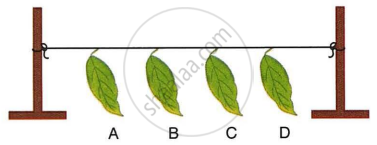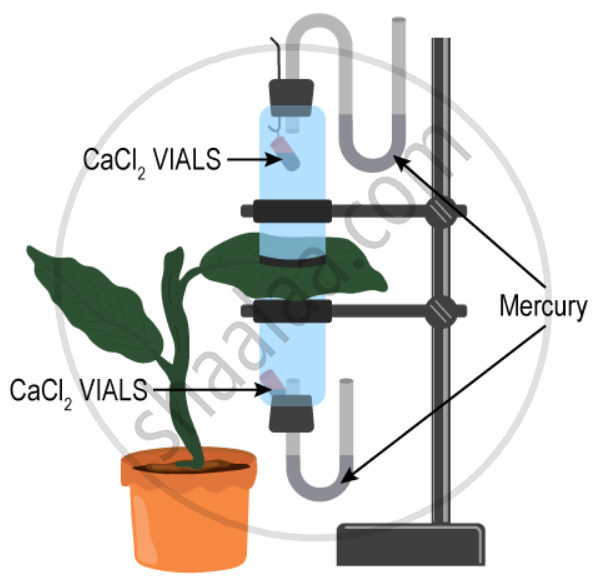Advertisements
Advertisements
Question
The given figure represents an experiment:

- Leaf A was coated with grease on both surfaces.
- Leaf B was coated with grease on the lower surface.
- Leaf C was coated with grease on the upper surface.
- Leaf D was left without any application of grease. All four leaves A, B, C and D were left in a room for about 24 hours.
- Which leaf dries first? Give reason.
- Which leaf dries last? Give reason.
Solution
- Leaf D: the leaf with no greasing on either surface would dry first, as it would shed the maximum amount of water from both surfaces.
- Leaf A: The leaf that was greased on both surfaces would dry out due to the fact that grease prevents water evaporation and transpiration by means of stomata, which are more prevalent on the lower surface of the leaf.
RELATED QUESTIONS
Name the following:
Any two parts of a leaf which allow transpiration.
The apparatus shown in the following diagram is Garreau’s potometer designed to demonstrate unequal transpiration from the two surfaces of a dorsiventral leaf. Before keeping the leaf in between the cups, anhydrous calcium chloride (CaCl2) contained in two small vials were weighed and placed in both the cups. The ends of the cups were closed with corks through which two mercury manometers were connected. After few hours, CaCl2 vials were taken out and weighed again.

What is the purpose of using a manometer?
Explain the Term
Stomatal transpiration
Given below are the diagrams of a certain structure in plants in two conditions.

(i) Name the structure shown.
(ii) Name the parts numbered 1-5.
(iii) What is the most apparent difference between A and B in the structure shown?
(iv) Describe the mechanism which brings about the change in the structure depicted in A and B.
Given below is the diagram of an experimental set up to study the process of transpiration in plants. Study the same and then answer the questions that follow:

(i) What is the colour of dry cobalt chloride paper?
(ii) Is the experimental leaf a monocot or a dicot? Give a reason to support your answer.
(iii) Why axe glass slides placed over the dry cobalt chloride papers?
(iv) After about half an hour what change, if any, would you expect to find in the cobalt chloride paper placed on the dorsal and ventral sides of the leaf? Give a reason to support your answer.
(v) Define the term ‘transpiration’.
Give Technical Term
Opening found on the undersurface of the dorsiventral leaf.
State the Location:
Stomata
Suppose you have a rose plant growing in a pot, how will you demonstrate transpiration in it?
Write a short note on lenticular transpiration.
